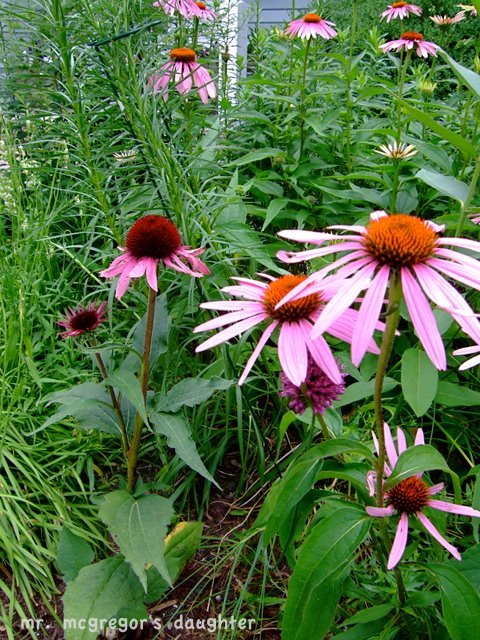
The Coneflowers (Echinacea purpurea) are in full bloom now, attracting all kinds of insects: honeybees and bumblebees,

other bees and wasps,

and even Japanese Beetles (which are not welcome).

The first sighting of a Monarch butterfly in the garden this year was on the Coneflowers.

They fill the front prairie planting and are scattered along the long border in partial shade in the back.

The Squirrelhaven Coneflowers are mostly seedlings from the local genotype and the cultivars 'Bright Star' and 'White Flower Farm Strain.' They exhibit much variation in size

and color.

After days of observing pollinators at the Coneflowers, I've come to an interesting conclusion: all of them prefer the species-type to the hybrid dwarf Echinacea 'Emily Saul' (After Midnight) on the left, which I planted this year.

While not conclusive proof, the following video supports this conclusion by a preponderance of the evidence. (I apologize for the quality of the video; this is my first one. I filmed for 10 minutes and edited it.)
The events depicted are typical, and the time and day were chosen at random (it was overcast and the camera battery was charged).I'm not suggesting that the fancy new hybrids shouldn't be planted. Instead, include a few Echinacea purpurea of the local genotype amongst those double, red, yellow, and dwarf Coneflowers. The pollinators will thank you.
(Edit. 7/24/09) I may have made the video too soon and rushed to judgement on inadequate evidence. Yesterday afternoon, I saw one bee visit the new flower on 'Emily Saul.' So it is probable that the existing flower was not fresh enough. However, it still appears that the bees favor the other Coneflowers more than 'Emily Saul,' as even when that bloom was fresh, I hadn't noticed bees visiting it. Draw your own conclusions.